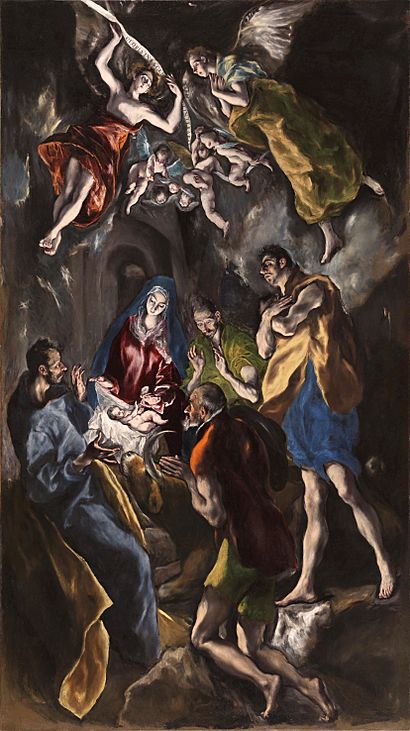The Adoration of the Shepherds (El Greco, Madrid) facts for kids
Quick facts for kids The Adoration of the Shepherds |
|
|---|---|
 |
|
| Artist | El Greco |
| Year | 1612–1614 |
| Medium | Oil on canvas |
| Dimensions | 319 cm × 180 cm (126 in × 71 in) |
| Location | Museo del Prado, Madrid |
The Adoration of the Shepherds is a famous painting by El Greco. He painted it in the last years of his life, between 1612 and 1614. This artwork shows a common scene from the Bible: the shepherds visiting baby Jesus.
El Greco created this painting to hang above his own tomb. His tomb was in a church called Santo Domingo el Antiguo in Toledo, Spain. You can see his signature, written in Greek, at the bottom left of the painting.
After a few years, El Greco's body was moved to a different church. However, the painting stayed at Santo Domingo until the 1900s. Today, you can see The Adoration of the Shepherds at the Museo del Prado in Madrid. Many people believe this was the very last painting El Greco ever made.
What Does the Painting Show?
In The Adoration of the Shepherds, El Greco used a special style. The bodies of the people in the painting look very long and stretched out. This was a common feature in his later works.
Baby Jesus seems to glow with a bright light. This light shines on the faces of the shepherds, who have come to honor his birth. The figures in the painting look like they are moving or even dancing. This creates a feeling of energy and rhythm.
El Greco also used strong contrasts between light and dark areas. This makes the scene feel very dramatic and powerful. Above the shepherds, a group of angels floats in the air. Some art experts think these angels might look like a missing part from another one of El Greco's paintings, called The Opening of the Fifth Seal.
See Also

- List of works by El Greco

